| Samoa: |
|
|
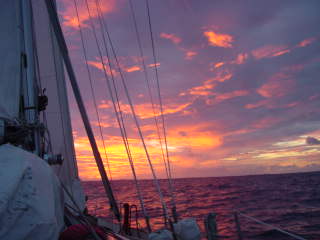
|
The 500 mile passage to Samoa was quite pleasant, if slow, until the wind headed us and then finally died 30 miles out from Apia, leaving us to motor through the night for an early morning landfall. We enjoyed a number of spectacular sunsets on the way, one of which we attempted to capture in the photo here
. |
|
|
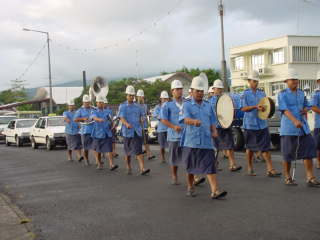
|
During the night, we were closely inspected and circled by another vessel, presumably from the Samoan coastguard. With tall hills, the islands had been clearly visible before dusk as we approached. With dawn coming, we hoped to pick up the leading lights before they were switched off, and luck was with us. With Junior steering, we could concentrate on following the precise line which led us between breaking waves to port and a hidden reef to starboard. The Government building, which wouldn’t be out of place in Trafalgar Square, soon showed to starboard of our line and a white church with twin towers – a miniature version of Notre Dame – straight ahead. Once into the harbour the wharf opened out and as we motored in to tie up the police brass band in blue uniforms and white pith helmets marched from its offices towards the government building for the morning national flag raising ceremony, playing Colonel Bogey.
|
|
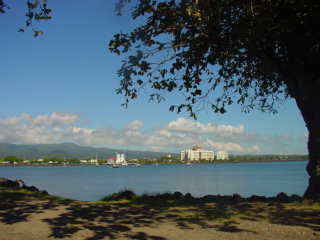
|
The harbour is dominated by the wharf (surprisingly busy with container ships loading and unloading day and night), the government building, the cathedral, and the river, alongside Aggie Grey’s hotel (a well-known local institution).
Various officials boarded the boat or stood above us on the wharf, handing down forms, and chatting, mostly about the recent rugger results. When we thought we had been cleared, we took down the Q flag, only to be reprimanded by the Health officer who was much later arriving, and who we weren’t expecting (having seen customs, quarantine, immigration and the harbour office). The harbour master was very helpful and friendly, showing us the showers – luxury! and a safe dinghy dock near his office. One had the choice of walking all the way round the harbour into the town, or taking the dinghy straight across and tying it to the rocks, admiring the brightly coloured coral and fish clearly visible just below the surface, even in the main
harbour.
|
|
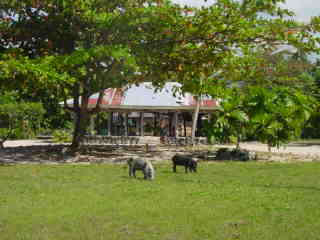
|
We spent a fortnight in Samoa and toured around the many villages on its two main islands – Upolu and
Savaii. To give you some idea of the picture that greeted us, imagine an English village 300 years ago with thatched roof hall houses (but no side walls) and instead of many pubs, many churches. Pigs and chickens roam freely around the village green, a meeting of a group of elders is visible in one of the open sided meeting rooms – a sort of Parish Council. |
Many of the scenes we saw as we drove around the country seemed identical to photographs taken 100 years ago. Who knows what happened before the coconut palm appeared – the tree, its leaves and fruit have over 180 documented uses! Together with bananas, fish, breadfruit and the pigs and chickens, it provides sustenance, shelter and work for the entire village.
|
|
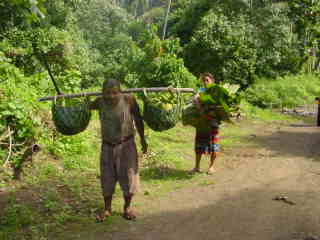
|
The modern (tarmac – probably ground up lava or coral) ring road which joins all the villages together seems strange, since so few people have cars. Brightly painted buses with the name of a single destination village painted onto the side provide communication and the route to market for most, though there are pickup trucks for some. We meet men carrying heavily laden banana leaf baskets, one at each end of a pole, walk back to the village at lunchtime or in the evening – like milk maids carrying buckets back from milking
, but without the benefit of a shaped carrier. Brightly coloured hedges divide properties from the road (typical village street), in some places there are lava gardens – a black lava patch planted with a few flowering plants; everywhere pandanus leaves for weaving are spread throughout the gardens to dry,
along with sleeping mats and washed clothes. Verges are neatly trimmed, even through the forests in between villages.
|
|
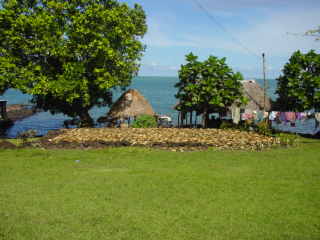
|
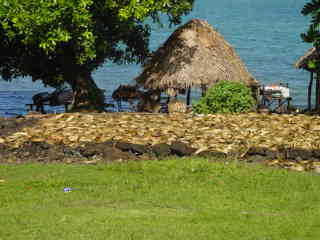 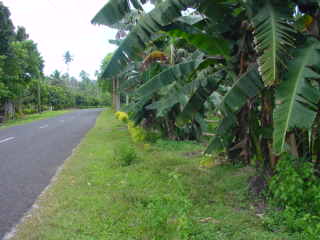
|
|
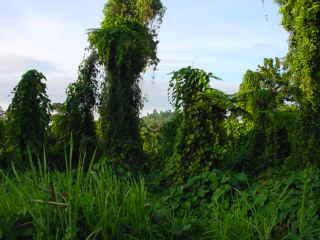
|
Interspersed between and around the villages are lush tropical green forest and plantations (except where they have been cleared for cattle), and overgrowing all untended vegetation, a vigorous giant creeper suffocating everything.
|
|
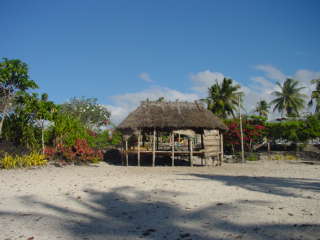
|
Leaving Apia, which, as a small city, has a certain old-fashioned slightly colonial charm, we are immediately struck by the village architecture. Almost everyone lives in open-sided “fale”. Some are traditionally built with thatched roofs, and woven coconut leaf blinds which can be lowered against sun or rain or wind, but which are generally pulled up
(fale with woven blinds). Others are built using corrugated iron or fibreglass for roofs, often brightly painted. But all are totally open, and most have little if any furniture. Many families seem to have more than one fale in their
curtilage, and it is clear that some are for meeting purposes and some for living. There is evidence everywhere of the weaving of pandanus leaves (very long, strong leaves). When we stopped to ask if we may watch the weaving, we are struck by how well cushioned the resulting mats are. The floors are still made of evenly graded but not small pieces of coral or lava, and are thus very hard! But just one layer of double woven pandanus renders the coral quite comfortable. In fact, tough coconut leaf mats are generally used as the bottom layer, and for sleeping 5 or 6 mats are layered on top of each other.
|
|
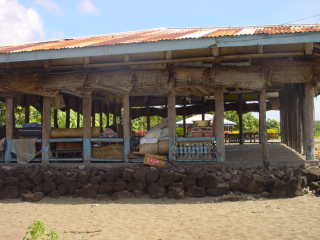
|
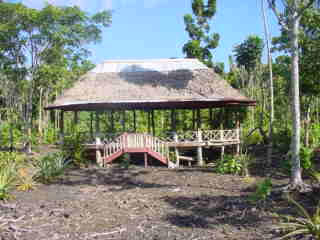 
|
|
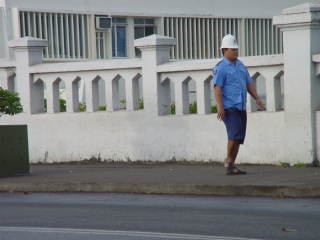
|
Samoan dress is distinctive too. Men routinely wear the lavalava – a wrap around skirt reaching to just below the knee - it is the standard uniform,
including that of the police force. After initial hesitation, and feeling unsafe in an un-sewn sarong of Helen’s, John took to wearing one with gusto,
and had two by the time we left. Compliments from Samoans abound everywhere we go! Women wear a short sleeved, closely fitting long tunic over an ankle length
lavalava, which is both modest and very elegant. Clearly this is not original traditional dress, but it is interesting to see how they have devised a post-missionary national dress. (Samoa took to the 19th century Christian missionaries with gusto, encouraged by the prophecy of one of their own goddesses of the arrival of a new religion in Samoa.) Even in the traditional dancing displays, grass skirts are shunned, at least by the women.
|
|
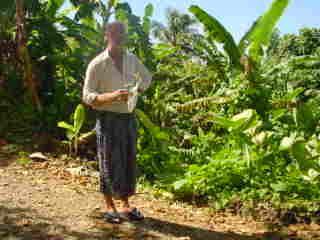
|
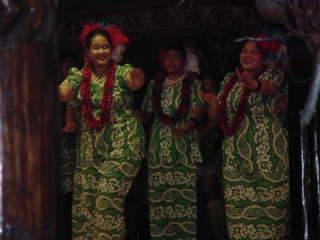
|
Women’s work and men’s work are both clearly defined. The clear distinction nonetheless means that both bring economic value to the family. Women’s work is principally in the creation of fine mats and tapa (bark) cloth, men’s in their pigs and other agricultural work. Traditionally, there are exchanges of gifts between families at ceremonial occasions. For example at a wedding, the bride’s family bring women’s gifts, and the groom’s family bring men’s gifts. These are not given to the couple, but are exchanged between the families. We were fascinated, to discover how the tradition continues. We got talking to a lady driving a pickup truck, laden with fine mats, who was alongside us on a ferry between the two main islands. She explained that she was taking the mats to a special family occasion as gifts. When we remarked on her generosity, she explained that she was expecting “some rewards” such as pigs. The occasion was the opening of a new church.
We bought a book written by a missionary and first printed in 1884 on the lives and customs of Samoa, and it is amazing how little seems to have changed, especially away from Apia. And looking at photographs on display at Robert Louis Stephenson’s house, taken some 100 years ago, we realised that many are identical to the ones we attach here. The Samoans are very proud of the “fa’a Samoa” – the Samoan way – and of their traditions and their success at maintaining them and resisting too much
westernisation.
The fine mats are indeed fine – still made of woven
pandanus, but cut into strips perhaps 1/16” across, so that the end result is smooth and cloth-like. These are not used to sit on, except for on special occasions, but are often worn as ceremonial
lavalavas. Tapa cloth, as in the Marquesas, is made from felted bark, pulped and beaten out by hand, but here the design is transferred by means of rubbing the dye over a carved board, rather like taking a brass rubbing. Printed cloth designs are striking and based on traditional tapa designs.
|
|
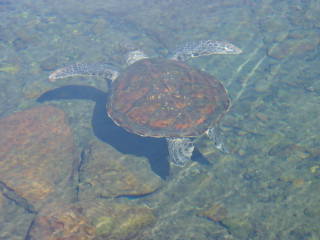
|
On Samoa’s other large, “wild” island, Savaii, we went to visit a turtle sanctuary, set in a mangrove wetland area, just back from the coast. After the sophisticated breeding programmes of the Galapagos, it was interesting to learn that at this stage, sanctuary here consists of rescuing turtles
caught by fishermen, and preserving them from the table. Nonetheless a good start! Sam, the young man who showed us his turtles, also agreed to paddle us round the wetlands in his canoe. This was made for two at most, so that we sat very still on our seats, with the water a mere inch or two below the top of the canoe, for a delightful short tour.
|
|
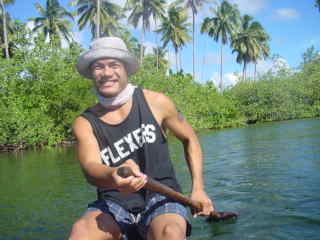
|
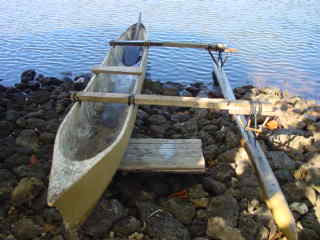
|
|
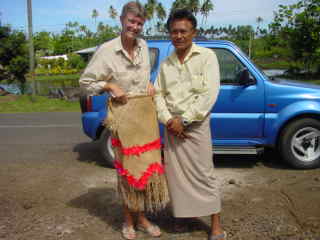
|
After stopping to watch some weaving, we were approached by the village chief, who asked if we would like to buy a mat, and kindly sold us a very special fine mat, decorated with bright pink feathers, of the type that would be used for ceremonies. He insisted on Helen wearing it for the photo rather than himself!
He took us into his fale, traditional in design, with little furniture but an enormous stack of mats of varying types and grades, from sleeping to wearing, and offered us our choice. Sadly we were unable to accept his invitation to have lunch with him, as we had to catch the ferry back to the main island.
|
|
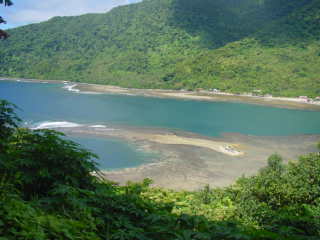
|
The islands are beautiful, with spectacular coastal scenery and dramatic forests, through which there were sometimes tracks passable by 4WD. One day we drove out to a remote village at the foot of one of the main stands of remaining rainforest, and famous for its carving. Here we found an interesting tradition of first creating the carved piece, then soaking it in a muddy swamp for some days to stain the outside of the wood, and then carving fine patterns into the outside (carving and weaving). In the photo you can just see an un-soaked bowl next to the carver, and also the weaving carrying on behind. On the way back, we were amused the see a pig foraging on the reef at low tide (reef foraging pig).
|
|
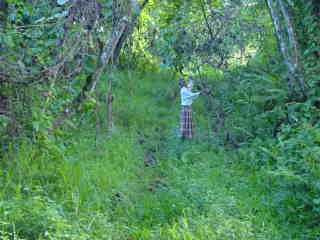
|
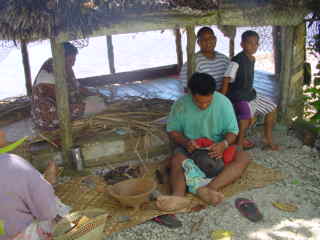 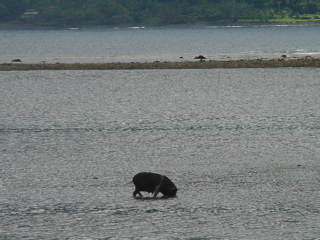
|
|
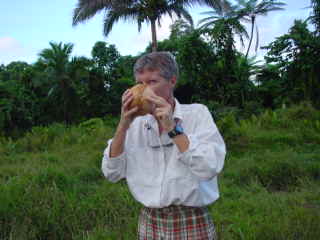
|
Returning to the importance of the coconut, a man we passed offered us a drinking coconut from his load, and later in the day, miles from anywhere, we stopped another man for the use of his knife to open it for a still refreshing drink. In the markets and on the roads, neatly constructed coconut leaf baskets are used to carry heavy loads. In Apia, coconuts of all stages of maturity were on sale – from drinking through to grating coconuts, as well as the ubiquitous bananas and one of the Polynesian staples, taro roots and yams.
We were also interested to see firewood on sale in the market in Apia, for those city dwellers who still cook over an open fire but have no access to the forests. The evenings in the harbour were strikingly scented by the smell of woodsmoke as evening meals were cooked.
|
|
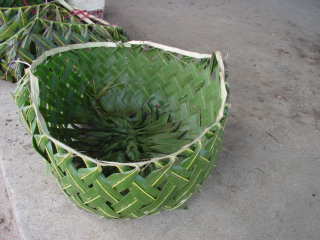
|
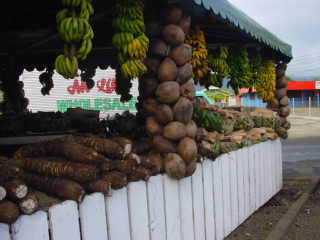
|
As contrast to all this local colour, we were delighted to find in Apia the only Anglican church in Samoa, where services were held in a mixture of Samoan and English, and the hymn tunes were familiar but with Samoan words, led by a choir and on organ! (All Saints, Apia) On our second Sunday we attended a confirmation by the Bishop of Fiji, Tonga and Samoa (wonderful title!). The service also included the licensing of 8 lay readers and the commissioning as Archdeacon Emeritus of one of them, who is on her way to New York as the Anglican Observer to the UN, having been selected by the Archbishop of Canterbury - a great source of pride for this small and delightful church.
We could write so much more about Samoa and all its delights - in Savaii we spent our first nights ashore since we left Vilamoura last October – but we hope this gives you something of a picture of a delightful people and place. After two weeks, we tore ourselves away, having decided to head almost due south for one of the northern-most island of Tonga,
Niuatoputapu.
Niuatoputapu: |
|
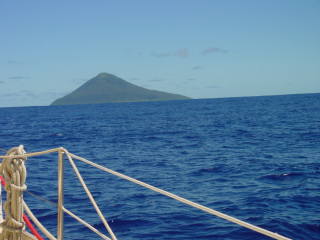
|
We had another slow-ish sail down to Niautoputapu, raising its sister island,
Tafahi, a pure volcanic crater, on the horizon first thing in the morning, and then having to motor to make it in through the reef entrance before dark. A couple of yachts were already in the anchorage when we arrived and several more arrived while we were there, so that at the most there were 6 boats.
|
Unusually because of the strict official constraint to stay aboard until cleared, the first 24 hours were spent on board completing some jobs and viewing the scenery. The village was apparent, consisting mainly of palm-roofed and corrugated iron houses, with occasional breeze block walls, totally enclosed, unlike the open-sided fale of Samoa. It was clear that there was no electricity - as it grew dark we could see the flare of fires and the occasional paraffin or gas lamp. On our first morning we were woken by a church bell at 0530 followed by singing unaccompanied except for a drum, giving an instant indication of the enthusiasm of the churches – there are 14 on this island of some 1200 people.
|
|
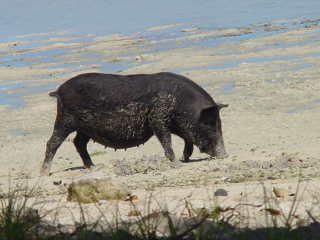

|
Niua is remote from the rest of Tonga (150 miles from the next group, Vava’u, and over 300 from the capital, still further south) with a supply boat calling irregularly once every two months. Trading consists largely of woven fine pandanus mats to the rest of Tonga, to ex-pat Tongans abroad and to the few visiting yachtsmen. Farming is largely to meet local needs, though kava growing is on the increase as an export crop. Yam, breadfruit, coconuts, paw paw all provide the basic foods, supplemented by fish, pigs and chickens. Pigs forage on the reef off the village at low tide and on the beaches (pig in sand). All children, but only some adults speak English. Schools appear well-attended – blue uniforms, with skirts for the girls and traditional “kiekie” (woven belts from which dangle woven strips), and lavalavas for the boys, with a short woven mat overskirt , known as a “ta’ovala”.
The kiekie and ta’ovala are traditional Tongan dress for all ages. The main town is unlike any other we have visited so far – several very small shops evident and blissfully no signs, not even for coca cola (perhaps because no electricity means no fridges). Phones however were installed in 1998, operating by satellite dish, and powered by a huge array of solar panels. There is just one multi-purpose government building.
|
 |
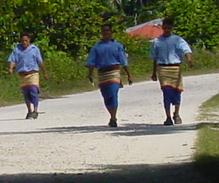 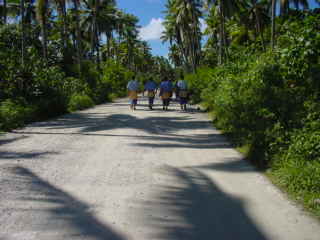
|
|
Our main contacts were with one extended family, led by Sia and
Nico. They were extremely hospitable, taking a small group of yachtsmen over to Tafahi with them when they went to visit members of the family; inviting us all to an umu earth oven family Sunday lunch; roasting a pig on a spit for us all one evening; organising an impromptu kava ceremony to raise funds for the church. In return, yachtsmen were subtly encouraged to offer items in short supply such as tinned meats, particularly corned beef and sausages; children’s clothes; shoes; petrol for outboard motors. All over the islands, children asked for sweets – “gimme lollay” a constant refrain. As one approached, they could be heard calling excitedly to one another: “palangi, palangi”, (meaning white man), partly from endless curiosity, and partly no doubt from the expectation of goodies.
Of necessity, with the infrequent supply ship and the absence of electricity, life here is very traditional. It was interesting talking to Government officials who are posted here from the capital, where life is clearly much more modern, how much they nevertheless appreciate the simple life in
Niua: no need to worry so much about money – nothing to spend it on; no refrigeration, but all needs supplied from the reef or the garden. Tonga as a whole is clearly also a traditional society, where, for example, overt mourning in the form of wearing black or black-edged clothing is still very much the custom, even among the young.
It was interesting to learn more about the construction and durability of the coconut roofs, which almost all houses use. They only last about a year, though they are cooler (and cheaper) than corrugated iron. Replacing a roof is a communal activity with people getting together to help each other, so that once all the roof panels are prepared, woven by the women, the replacement can be accomplished in a couple of days. There doesn’t seem to be the same formal division of women’s work and men’s work here as in Samoa.
Families all play a part in the weaving process, cutting, washing, soaking, drying We learnt much more about the weaving of pandanus leaves into fine mats here. The floors of the houses were made from beaten earth or concrete, so no need for the thickly cushioned mats as in Samoa; even the floor mats were finer. Niua is one of the few places in Tonga which grows a particular type of pandanus suitable for making very fine mats to wear, so they are made here to order. The processing of the pandanus leaves is very time-consuming and complicated. This pandanus variety has leaves with very sharp thorny edges and spines, which must first be cut off, rather like stringing beans. Then they are rolled and tied in small bundles and boiled for about 15 minutes over an open fire. Once cool, the leaves are peeled in half down the thickness of the leaf, with only the shiny side retained for use. These are tied and put into the sea, weighted down in a shallow part of the reef by stones, so that the salt soaks and softens them, for about a week. They have to be checked every couple of days to ensure that they are not collecting silt, weed or crabs. Then they are rinsed in fresh water, dried, soaked again in fresh water, shaken and rolled up into ringlets, which are hung up to dry on washing lines. Finally they are coiled into large flat coils and are ready to use.
|
|
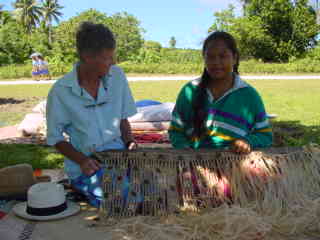
|
A small piece of metal (often half a tin lid) is run along the dried leaf to smooth and straighten it, then each long flat piece of leaf (the leaves are about 3-4 feet long) which is now about 1½ inches wide is cut into 5 or 6 narrow strips for the relatively fine floor mats, much narrower for the mats to wear, leaving a small section at the end joined for ease of handling. The weaving itself is all done totally by hand, of course, and each alternative warp piece has to be lifted to allow the weft to be placed across (weaving hands). The warps are then all pulled in the opposite direction – upper ones down, lower ones up, and pulled tightly to ensure good tension, and then the next weft piece can be laid on. This is a long slow process with pieces of leaf cut so thin! In some cases, such as for ta’ovalas, decorative patterns are woven in, either by leaving a pattern of holes, as in one of our photos (fine mat to wear) or by weaving in a different colour of leaf, either died or processed differently. One gorgeous mat Helen saw had been plainly woven; then a flower and edging pattern was made by pasting shaped leaves onto the mat with yam paste; and then the whole mat was hung in the smoke of a fire made from green coconut shells and other green material. The result was a beautiful, glossy, rich milky-coffee coloured mat with the flower and edging patterns left in relief. Most weaving is done communally (communal weaving), with at least two and often more women working together on one mat at a time, and others working on preparing the leaves.
|
|
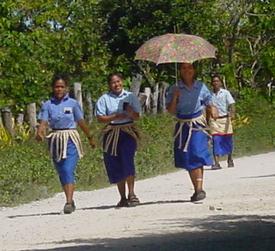
|
The women’s kiekie are often not woven at all, but use a type of crochet work, often still in pandanus leaf, with shells or beads as decoration
and these tend to be made by each individual for herself. Young girls we met who didn’t, or couldn’t weave, were nonetheless making their own kiekie.
|
|
Sunday is definitely kept as a special day in Tonga. We attended a packed, tiny Catholic church for mass, sitting on a lino covered floor, again with the most magnificent unaccompanied singing, which resonated in the low-roofed building, and a friendly priest who gave us a translated précis of his sermon. After church, all yachtsmen were invited by Sia and Nico to a traditional earth oven “umu” Sunday lunch. We contributed some corned beef and tinned tuna, which were wrapped in banana leaves and baked, together with mutton, similarly wrapped; yams baked whole; pawpaw cut up and placed in a pan with coconut cream (made from grating mature coconuts into water and wringing out the resultant liquid) – all absolutely delicious. The photos show some of the sequence of the umu – first rocks are heated in a hole dug in the ground, and then the food is piled on top of these in sequence – yams first, then the banana leaf parcels and the pan, and so on. The food is then insulated with green banana leaves, coconut husks, sacking and finally earth, and left for about an hour to bake.
|
|
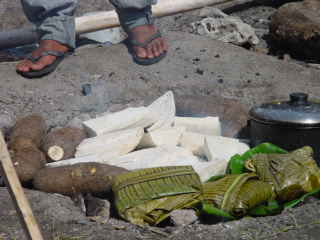
|
 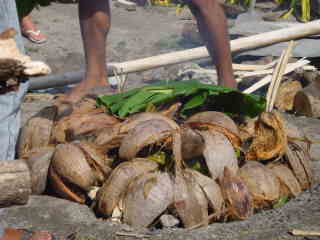
|
|
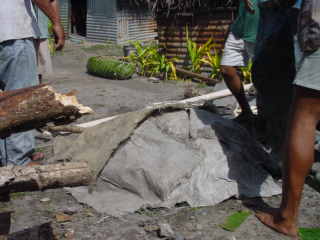
|
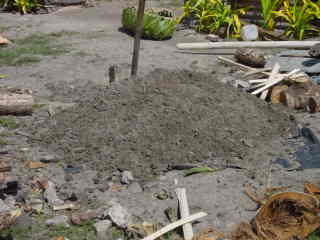 
|
|

|
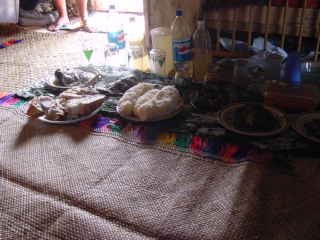
|
After lunch families sit outside their houses and talk – no weaving is done, no work of any kind, and it was clear from the singing drifting across the anchorage later, that many people attend two services at church.
The trip to Tafahi was most interesting too, showing us an even more isolated life on an island an hour from Niua, with no shop of its own, and no direct visit by supply ship, but three churches and two schools for its 200 odd people. While we were sitting on the beach, watching the pandanus preparation and the weaving, we were very lucky to see some humpback whales swim past, breaching almost completely clear of the water in a spectacular display. We saw them again returning from Tafahi, from a safe distance, and it was lovely to see them so, with no need to worry about the impact should they hit Flame, as a mature whale is bigger than Flame and its acrobatics could cause us serious damage.
Finally we had to tear ourselves reluctantly away to set off for Vanuatu (formerly known as the New Hebrides), 1100 miles almost due west from Niua and straight across the northern edge of Fiji.
|